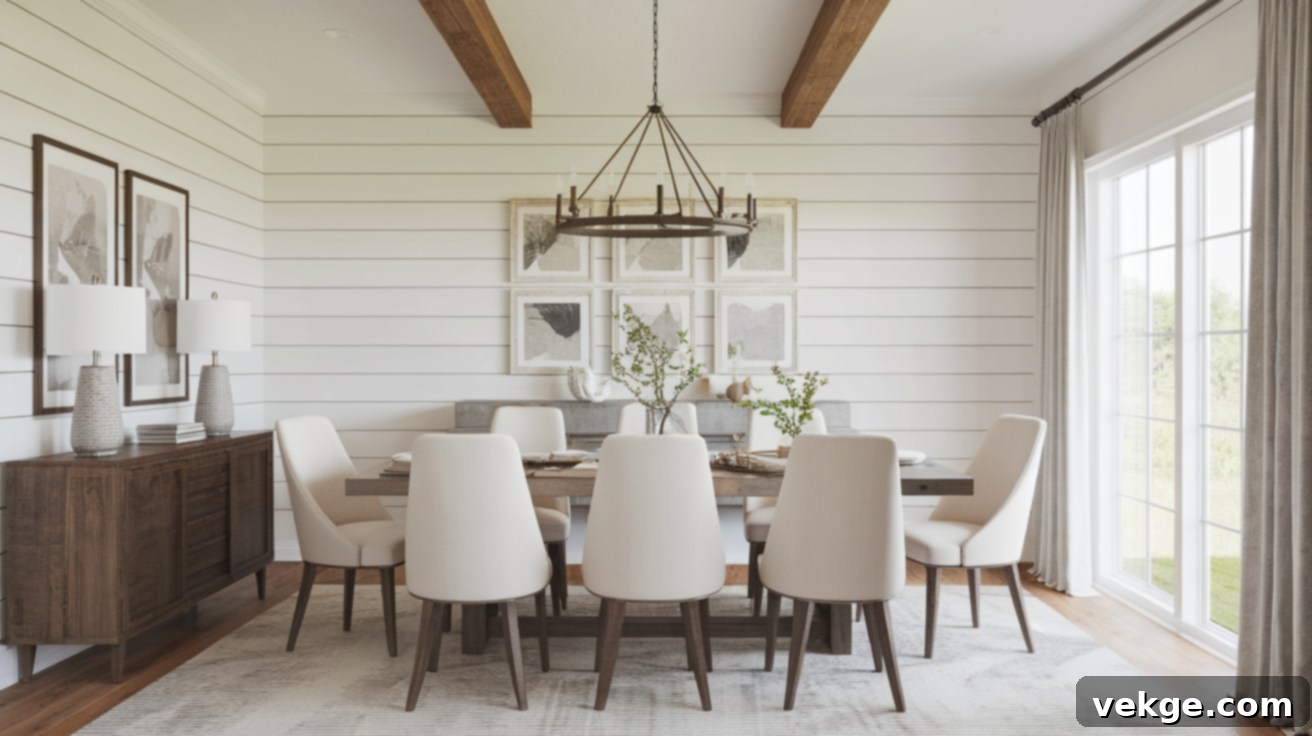Farmhouse Accent Walls: Design Ideas, DIY Guide, & Style Tips for Every Home
Farmhouse accent walls have emerged as a beloved interior design trend, effortlessly infusing modern homes with warmth, character, and a touch of rustic charm. These distinctive walls transform ordinary rooms into inviting, focal points, creating spaces that feel both stylish and deeply personal. Whether you’re drawn to the crisp lines of shiplap, the weathered beauty of old barn wood, or the dynamic texture of board and batten, there’s a farmhouse accent wall style to complement any aesthetic.
Versatile and visually striking, farmhouse accent walls can enhance almost any room in your home. Imagine them in a spacious living room, adding depth to a cozy bedroom, bringing character to a functional kitchen, or even making a statement in a small entryway or reading nook. One of the most appealing aspects of this design element is its accessibility: you can achieve a stunning look on a budget with a DIY project, or invest in a custom professional installation for a truly bespoke finish.
If your goal is to make your home feel more inviting, personal, and effortlessly stylish, a farmhouse accent wall could be the perfect solution. These seemingly simple additions possess the power to make a significant impact, elevating your home’s ambiance and impressing both you and your guests. They are more than just a decorative feature; they are an invitation to embrace comfort and timeless design.
Ready to discover how to upgrade your living space with this captivating design element?
What is a Farmhouse Accent Wall? Unveiling the Charm
A farmhouse accent wall is a single wall within a room that intentionally stands out from the others, distinguishing itself through its unique materials, distinct colors, or captivating textures. Unlike painting all walls the same shade, an accent wall draws the eye and anchors the space, becoming the room’s undeniable focal point.
In the context of farmhouse-style homes, these special walls are integral to adding a sense of history, character, and comfort. They are designed to evoke the simple, authentic aesthetics of rural living, bringing a cozy, country feel into even the most contemporary residences. The essence of a farmhouse accent wall lies in its ability to blend rustic elements with modern sensibilities, creating a balanced and harmonious environment.
The most popular choices for farmhouse accent walls often feature natural, tactile materials that tell a story. These include the classic horizontal wooden boards known as shiplap, which offer clean lines and a breezy feel; weathered barn wood or reclaimed timber, prized for its rich patina and distressed character; and board and batten, a striking pattern of vertical boards interspersed with thinner horizontal strips, creating an elegant three-dimensional effect.
Typically, these accent walls are finished in a palette of neutral colors. Whites, soft grays, gentle creams, and warm natural wood tones are favored for their ability to create a calm, welcoming, and serene space. This restrained color scheme allows the texture and material of the wall to truly shine, highlighting the craftsmanship and natural beauty inherent in the design.
The enduring appeal and simple beauty of farmhouse accent walls stem directly from their use of basic, honest materials and modest designs. These elements pay homage to traditional rural building methods, celebrating durability, functionality, and an understated elegance that never goes out of style. They are a testament to the idea that true beauty often lies in simplicity and authenticity.
Best Farmhouse Accent Wall Ideas for Every Room
Farmhouse accent walls possess the remarkable ability to entirely transform the atmosphere of a room without necessitating extensive renovations across the entire space. Here are some inspiring ideas tailored for different areas within your home, helping you envision the perfect design.
Living Room Accent Wall Ideas: Creating a Cozy Hub
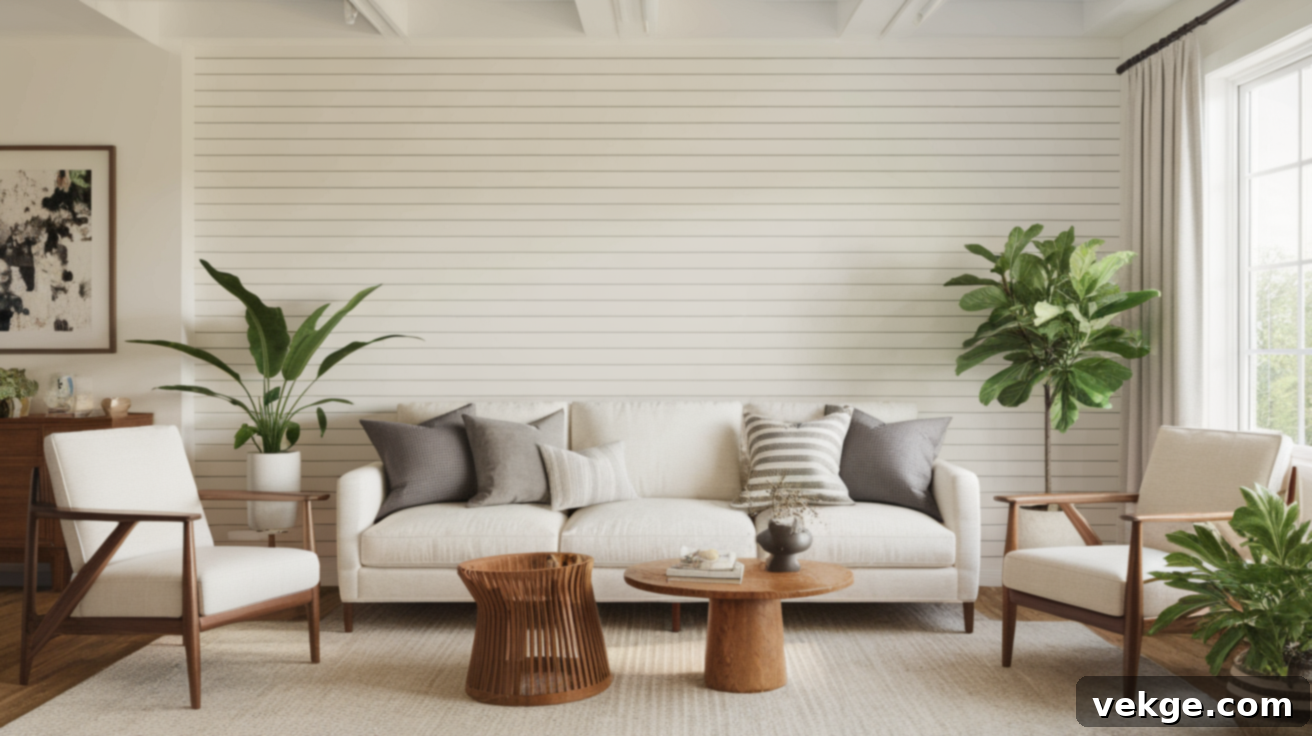
The living room often serves as the heart of the home, making it an ideal candidate for a standout accent wall. A shiplap wall, painted in crisp white or a serene light gray, introduces a clean, fresh aesthetic that works beautifully as a backdrop behind a sofa, an entertainment center, or even a cozy reading nook. Its horizontal lines can also make a room feel wider and more expansive.
Alternatively, wood paneling, showcasing its natural grain and texture, instantly adds warmth and depth. These walls can elevate even the most basic living room, making it feel more inviting and thoughtfully designed. The versatility of wood allows it to pair seamlessly with a variety of furniture styles, from plush fabric sectionals to sleek leather armchairs, enhancing the room’s tactile appeal.
Consider the interplay of colors and textures: a light-colored wood accent wall creates a striking contrast when paired with rich navy or deep gray sofas, adding a sophisticated touch. Conversely, a classic white shiplap wall provides a timeless, airy background that beautifully highlights natural wooden furniture pieces, vibrant green houseplants, and intricate decorative accents, allowing them to truly pop.
Bedroom Accent Wall Ideas: Your Serene Retreat
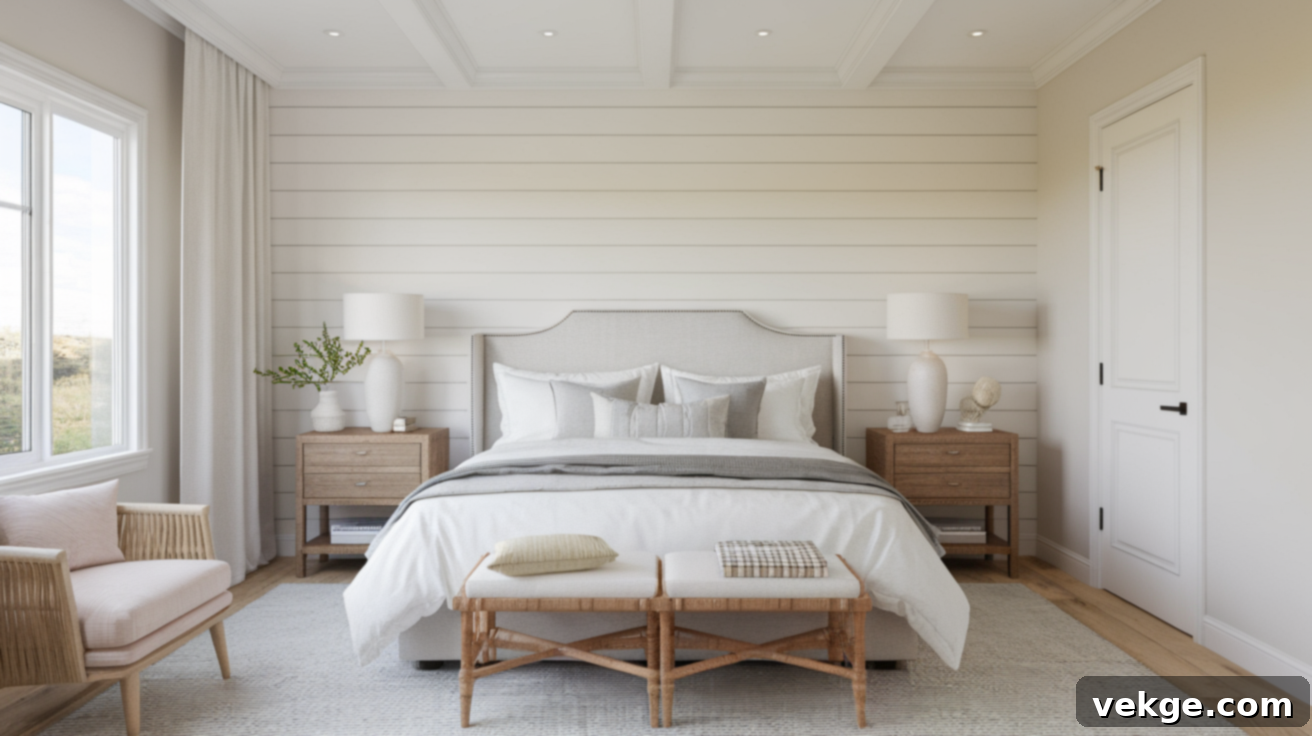
In the sanctuary of the bedroom, farmhouse accent walls play a crucial role in fostering a peaceful and restorative retreat. A board-and-batten wall installed behind the headboard creates a powerful visual statement, offering a striking backdrop that often requires minimal additional decoration. The geometric pattern of the boards introduces architectural interest and subtle texture while maintaining an overall sense of calm and order, perfect for a sleeping space.
While white remains a perennially popular choice for bedroom accent walls due to its brightness and serenity, don’t shy away from exploring other calming hues. Soft grays, tranquil pale blues, and gentle earth tones like sage green or warm beige also work wonderfully. These colors are known to promote relaxation and rest, all while injecting personal style and sophistication into your private space.
To enhance the cozy ambiance and highlight the intricate details of your accent wall, consider installing wall sconces. Positioned strategically, these fixtures cast a warm, inviting glow, emphasizing the texture and depth of the wall treatment. This thoughtful lighting not only adds to the room’s aesthetic but also provides functional, soft illumination ideal for evening relaxation.
Kitchen Accent Wall Ideas: Infusing Charm and Practicality
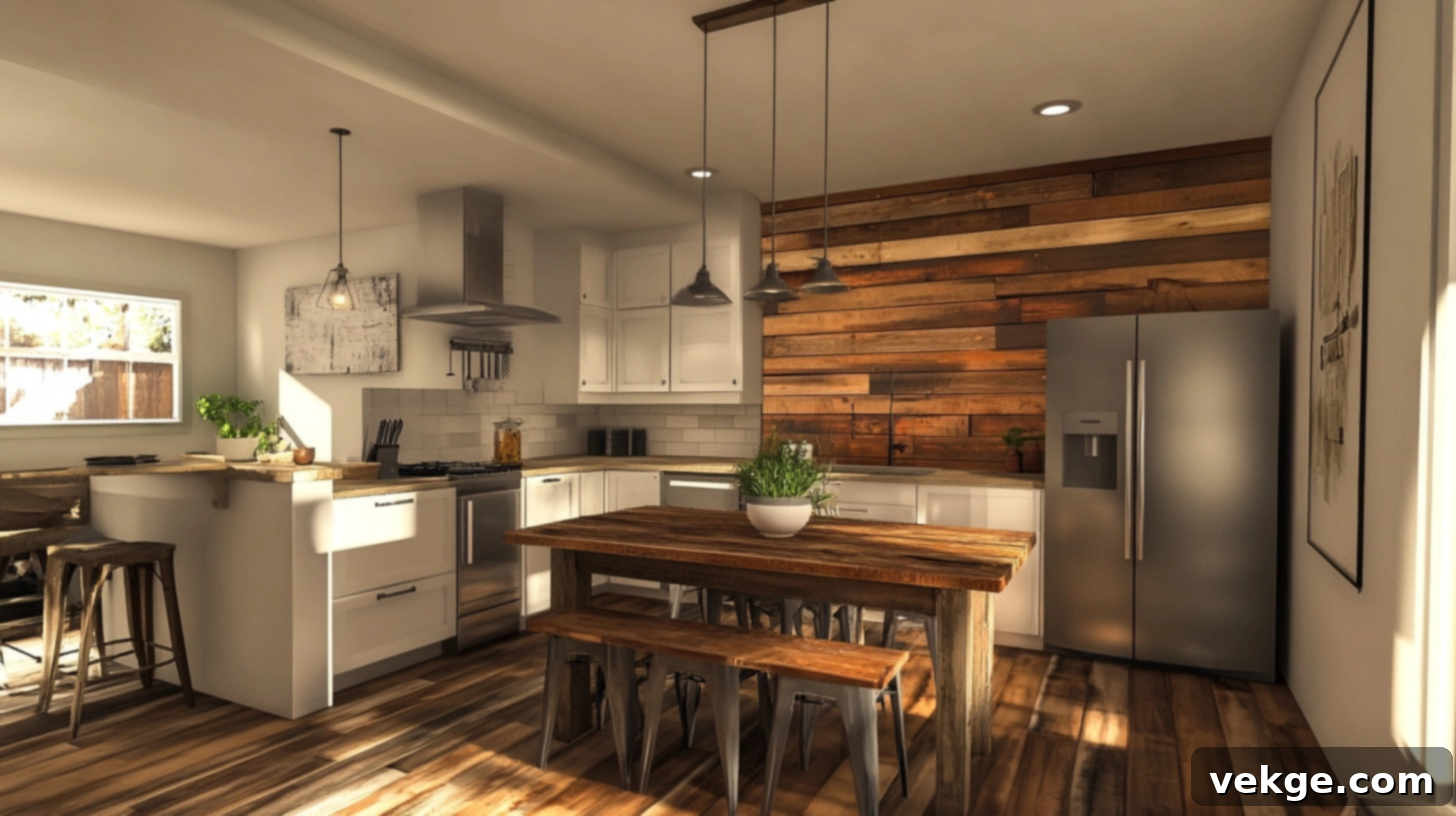
Kitchens can significantly benefit from farmhouse accent walls, which add character and personality while being durable enough to withstand daily use and potential splatters. A reclaimed wood wall behind a dining area or breakfast nook instantly creates a warm, inviting focal point, perfect for shared family meals and lively conversations. The aged wood adds a rustic, storied feel that is both charming and robust.
Alternatively, painted panels in crisp white or creamy off-white shades bring an authentic farmhouse look to the space without making it feel dark or enclosed. These lighter tones reflect light, keeping the kitchen bright and airy, even in smaller layouts. When selecting materials for kitchen accent walls, practicality should be a primary consideration.
For areas prone to splashes, such as behind stoves or sinks, opt for materials that are easy to wipe clean and maintain. Beadboard panels or painted wood planks offer the classic farmhouse aesthetic with the added benefit of enhanced durability and ease of cleaning, ensuring your beautiful wall remains pristine. Materials treated with washable paints or protective sealants are also excellent choices.
Even a small section of an accent wall can make a significant impact in a kitchen. Consider integrating an accent treatment inside open shelving, under a breakfast bar, or even as a unique backsplash alternative. These thoughtful touches can tie the whole kitchen together, adding unexpected charm and a custom feel without overwhelming the space.
How to Build a DIY Farmhouse Accent Wall: Your Step-by-Step Guide
Embarking on a DIY farmhouse accent wall project can be incredibly rewarding, not only saving you money but also ensuring you achieve the exact look and feel you envision for your home. With a few basic tools and materials, you can craft a beautiful and personalized feature wall that truly stands out.
Guide to Installing Shiplap Walls Like a Pro
Shiplap is a classic choice for a farmhouse accent wall, offering a clean, horizontal line that instantly evokes rustic elegance. Here’s how to install it yourself:
- Gather Your Materials and Tools: You’ll need shiplap boards (or 1×6 pine boards which can mimic shiplap with a gap), a miter saw or circular saw, a nail gun (with 1.5-2 inch finish nails), wood glue, a level, a stud finder, a measuring tape, pencil, painter’s caulk, wood filler, and your chosen paint or stain. Safety glasses and gloves are also essential.
- Prepare the Wall Surface: Begin by clearing the wall of any existing decorations, wall plates, nails, or hooks. Fill any holes or imperfections with spackle and sand the wall smooth for a clean base. Use a stud finder to locate and mark the wall studs with a pencil; these are crucial for securely nailing your boards.
- Measure and Precisely Cut Boards: Measure the exact height and width of your wall. Carefully cut your first shiplap board to the correct length, ensuring both ends are perfectly straight and square. It’s often helpful to cut all the boards for one row at a time, or even pre-cut several boards if your wall dimensions are consistent.
- Start from the Bottom, Level and Secure: Place your first board flush against the bottom of the wall. Use a long level to ensure it is perfectly horizontal. Apply a bead of wood glue to the back of the board for extra adhesion, then use your nail gun to fasten it securely into the wall studs you marked earlier.
- Continue Upward with Consistent Gaps: For subsequent rows, the characteristic “shiplap look” is achieved by leaving a small, consistent gap between boards (typically about 1/8 inch or the thickness of a coin). You can use spacers or even a nickel to maintain this uniform spacing. Before nailing, always double-check that each new board is perfectly level.
- Carefully Cut Around Obstacles: When you encounter electrical outlets, light switches, or windows, use a jigsaw to meticulously cut out the necessary holes in the shiplap boards. Remember the carpenter’s adage: “Measure twice, cut once” to avoid costly mistakes. Ensure the cuts are snug and clean.
- Finish the Top Row Seamlessly: The final board at the top of the wall may need to be cut lengthwise (ripped) to fit the remaining space. Measure this last gap very carefully and make a precise cut for a clean, professional finish that meets the ceiling or crown molding.
- Finishing Touches: Paint or Stain: Once all the boards are installed, use wood filler to fill any visible nail holes. Allow it to dry, then sand lightly until smooth. You can also caulk any small gaps where the shiplap meets adjacent walls or trim. Finally, apply your chosen paint or stain to achieve the desired farmhouse aesthetic, ensuring even coverage for a polished look.
Affordable DIY Farmhouse Accent Wall Ideas for Budget-Conscious Decorators
Achieving the beloved farmhouse look doesn’t always require a large budget for real wood panels. Thankfully, there are numerous cost-effective and creative ways to infuse your home with rustic charm:
- Peel-and-Stick Planks: For an incredibly simple and tool-free solution, peel-and-stick wood planks or shiplap-style wallpaper offer instant transformation. Simply peel off the backing and press them onto your wall for an impressive faux wood finish. They are perfect for renters or those seeking a temporary update.
- Painter’s Tape and Paint Magic: Create the illusion of board and batten without any actual wood! Use painter’s tape to mark out your desired grid pattern directly on the wall. Paint the entire wall (including over the taped lines) with your chosen color. Once dry, carefully remove the tape to reveal a striking, two-toned board and batten effect that is surprisingly realistic and incredibly budget-friendly.
- Repurposed Wooden Pallets: Seek out free wooden pallets from local businesses or construction sites. Disassemble them carefully, sand the wood thoroughly to remove splinters, and then mount the individual planks to your wall. This method provides an authentic, rustic look with genuine reclaimed wood, making it a truly budget-friendly and eco-conscious option.
- Plywood Strips for Custom Designs: Purchase thin sheets of plywood and have them cut into strips of varying widths at your local hardware store. These strips can then be painted, stained, or whitewashed and mounted to your wall to mimic more expensive shiplap or planking treatments. This offers immense customization for patterns and finishes at a fraction of the cost.
- Faux Brick Panels: For a different kind of rustic texture, consider faux brick panels. These lightweight panels are easy to install and, when painted white or a light gray, provide the charming, weathered look of real brick without the weight, expense, or intricate installation. They add an industrial-farmhouse edge that is very appealing.
These inventive and money-saving methods allow you to enjoy the timeless charm and inviting warmth of farmhouse style without having to empty your wallet, proving that stunning home decor can indeed be achieved on any budget.
Choosing the Right Materials for Your Farmhouse Accent Wall
The materials you meticulously select for your farmhouse accent wall will profoundly influence not only its aesthetic appeal but also its long-term durability and the overall atmosphere it creates. Thoughtful consideration of your options is key to a successful project.
Wood vs. Wallpaper: A Material Showdown
Real Wood: There’s an undeniable allure to real wood. It inherently brings natural warmth, authentic texture, and robust durability to your farmhouse accent wall. Genuine wood planks, whether shiplap, reclaimed barn wood, or traditional paneling, add a tangible depth and character that synthetic materials cannot fully replicate. A significant advantage is its ability to be refinished or repainted over time, allowing for future style updates. However, real wood typically costs more and requires a more skilled installation process. It represents a long-term commitment that ages beautifully, developing a rich patina and story over the years.
Farmhouse-Style Wallpaper: In contrast, high-quality farmhouse-style wallpaper or peel-and-stick options offer a significantly more budget-friendly and DIY-friendly alternative. They are much easier to install and replace, making them ideal for renters or those who like to frequently refresh their decor. Modern wallpapers are incredibly sophisticated, effectively mimicking the look of wood grain, shiplap patterns, or even distressed brick from a distance. While they may lack the true three-dimensional quality and tactile feel of real wood, advancements in texture and printing technology make them a compelling option. However, it’s worth noting that wallpaper may not hold up as well in high-humidity environments like bathrooms or kitchens compared to properly sealed wood.
Ultimately, your choice between wood and wallpaper will depend on a confluence of factors: your allocated budget, your comfort level with DIY installation, the desired permanence of the feature, and the specific functional requirements of the room.
Best Paint and Finishes for Authentic Farmhouse Walls
The right paint and finish are crucial for capturing the quintessential soft, cozy look that defines farmhouse style. For accent walls, matte or eggshell finishes are highly recommended. These low-sheen options create a soft, velvety appearance that diffuses light beautifully, contributing to a warm and inviting atmosphere. An added practical benefit is their ability to conceal minor wall imperfections and subtle textural variations more effectively than glossy paints, which tend to highlight every flaw.
When it comes to color, popular choices universally gravitate towards warm whites, such as the renowned Benjamin Moore’s “White Dove”, celebrated for its subtle cream undertones that prevent it from feeling stark. Soft neutrals are also favored, with shades like Sherwin-Williams’ “Agreeable Gray” offering a versatile balance between warm and cool tones. For natural wood walls, a whitewash technique is a fantastic option; it allows the inherent beauty of the wood grain to show through while brightening the overall look, providing a charming, slightly distressed aesthetic.
For an authentic, aged, and rustic finish, milk paint and chalk paint are ideal. These specialized paints create a soft, matte surface that adheres well to various materials and can be easily distressed by light sanding, particularly on edges and raised areas, to achieve a beautifully worn appearance. This technique perfectly embodies the farmhouse ethos of embracing imperfections and history. To protect your finished accent wall while preserving its low-sheen farmhouse look, consider applying a matte-finish wax or a water-based polyurethane sealant. These protective layers will guard against wear and tear without introducing an undesirable shine.
Farmhouse Accent Wall Color Trends: From Timeless to Modern
The colors you choose for your farmhouse accent wall are pivotal in establishing the room’s mood and overall aesthetic. From time-honored light neutrals to more contemporary, deeper tones, your color selection can ensure your wall feels classically timeless or give it a fresh, modern edge.
Classic White and Neutral Tones: The Foundation of Farmhouse

White, in its myriad forms, remains the undisputed cornerstone of farmhouse design for compelling reasons. A white accent wall instantly brightens any room, making smaller spaces feel more expansive and airy. It provides a clean, crisp, and versatile backdrop against which other decorative elements—be they vibrant textiles, natural wood furniture, or metallic accents—can truly shine. While pure whites offer a clean and minimalist look, off-whites and creams introduce a touch more warmth and softness, creating a welcoming embrace.
Light gray has also firmly established itself as another essential farmhouse staple. It offers a subtle yet sophisticated contrast against white trim and ceilings, maintaining an open, airy feel while adding a touch more depth than pure white. Soft beige and tan tones, on the other hand, bring a comforting warmth to a space, making them excellent choices for rooms that receive less natural light, helping to prevent them from feeling cold. These versatile neutral shades are incredibly easy to pair with a wide array of decor, from natural wood furniture and wrought iron accents to organic cottons and chunky knit textiles, creating a cohesive and harmonious design.
Bold Accents for a Modern Twist: Infusing Personality
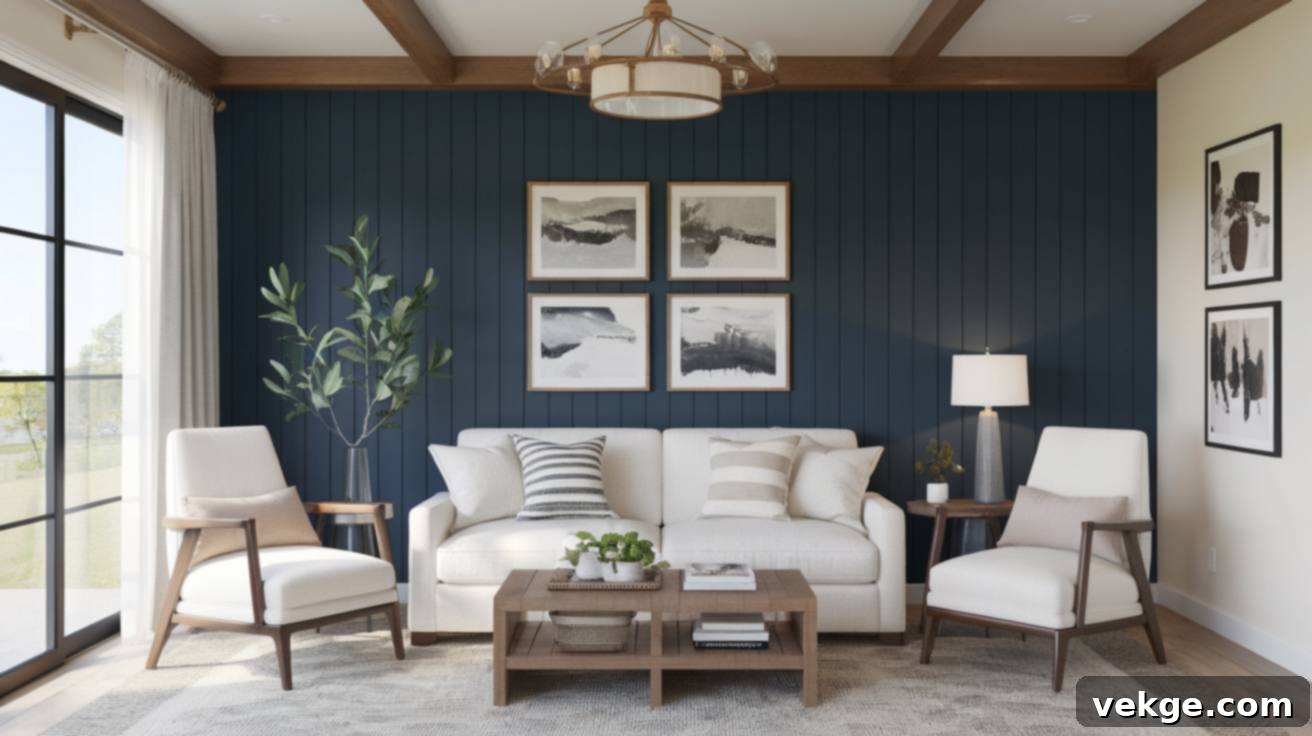
Today’s evolving farmhouse style frequently embraces a delightful fusion of traditional elements with more contemporary, bolder color choices, creating unique and dynamic spaces. A rich navy blue accent wall, for instance, pairs exquisitely with classic white trim and natural wooden elements, introducing significant depth and a refined sophistication without veering too far into a purely modern aesthetic. It offers a cozy, cocooning feel perfect for a bedroom or a sophisticated study.
Deep green hues, ranging from forest green to a muted olive, bring the serene beauty of nature indoors, working particularly well in dining rooms, home offices, or even a cozy reading nook. These earthy tones connect the space to the outdoors and create a sense of tranquility. Charcoal gray provides a striking and dramatic alternative to stark black, offering profound contrast without the harshness. These darker, more saturated colors are especially effective when applied to a fireplace wall, creating an impressive architectural statement, or behind significant pieces of furniture, making them stand out.
For those who desire a touch of color but prefer not to commit to very dark shades, muted blue-grays and tranquil sage greens offer an ideal middle ground. These softened, sophisticated hues beautifully honor the rustic roots of farmhouse style while feeling refreshingly current and elegant, providing a gentle pop of color that enhances rather than overwhelms the room’s design.
Maintenance Tips for Your Farmhouse Accent Wall
Ensuring your farmhouse accent wall retains its pristine beauty and charm for years to come requires consistent care and attention. With proper maintenance routines, your wall will continue to be a stunning focal point in your home.
For authentic wood accent walls, regular dusting with a soft, dry cloth or a microfiber duster is essential to prevent dirt buildup in the grain. Additionally, applying a wood conditioner annually can help prevent the wood from drying out, cracking, or losing its luster. For textured walls, such as those with deeper grooves or dimensional patterns, occasional vacuuming with a soft brush attachment is highly effective for removing dust and cobwebs from crevices where a cloth might not reach.
- Dust Weekly: Use a soft, dry cloth or a microfiber duster to gently wipe down your accent wall, preventing dust and allergens from accumulating.
- Avoid Excessive Moisture: For real wood walls, avoid wet cleaning methods or harsh chemical cleaners, as these can damage the finish, warp the wood, or cause discoloration.
- Prompt Touch-Ups: Address any paint chips, scratches, or minor dings as soon as they appear. Keep a small amount of your original paint or stain on hand for quick and seamless touch-ups.
- Protect from Sunlight: If possible, shield your accent wall from prolonged direct sunlight, especially if it’s painted or stained, as UV rays can cause colors to fade and wood to dry out. Use blinds or curtains during peak sun hours.
- Vacuum Textured Surfaces: For walls with significant texture (like board and batten or deeply grooved shiplap), use a vacuum cleaner with a brush attachment to remove dust that settles in grooves and crevices.
- Mind Furniture Placement: Position furniture a few inches away from the accent wall to prevent scuffs, scratches, and rub marks that can mar the finish over time.
- Clean Spills Immediately: For painted or sealed walls, clean any spills or marks quickly with a damp cloth and mild soap (if safe for the finish) to prevent staining or damage.
- Seasonal Inspections: During your seasonal cleaning routines, take a moment to inspect your accent wall for any loose boards, peeling paint, or other signs of wear, addressing them promptly to maintain the wall’s integrity.
Conclusion: Embrace the Farmhouse Charm
Farmhouse accent walls offer a wonderfully straightforward yet incredibly impactful way to inject warmth, character, and a personalized touch into any home. Whether you’re drawn to the classic appeal of shiplap, the rugged authenticity of rustic reclaimed wood, or the modern elegance of board and batten, these feature walls serve as captivating focal points that instantly elevate your space. They transform an ordinary room into an extraordinary one, making it truly stand out.
With a plethora of affordable DIY options, a versatile range of color choices—from crisp, bright whites that expand a space to bold navy blues that add dramatic depth—and simple, manageable maintenance routines, creating your very own farmhouse accent wall is a completely achievable goal. It’s a project that empowers homeowners to take control of their interior design and infuse their personality into their living environment.
The enduring beauty and timeless appeal of farmhouse style lie precisely in its simplicity and honesty: an appreciation for natural materials, clean lines, comfort, and an overarching welcoming feel. This aesthetic celebrates the beauty of understated design and functional elegance, creating spaces that feel both lived-in and thoughtfully curated.
Take that inspiring first step toward upgrading your space and enhancing your home’s ambiance. Embrace the charm and character that a farmhouse accent wall can bring, transforming your everyday living into an experience imbued with rustic elegance and inviting comfort. It’s more than just a wall; it’s a statement of style and a commitment to creating a home you truly love.
Frequently Asked Questions About Farmhouse Accent Walls
Can I install a farmhouse accent wall in a small space?
Absolutely! Accent walls are particularly effective in small rooms as they can make the space feel cozier and more intentionally designed. Opting for light colors and horizontal patterns, such as shiplap, can even create the illusion of a larger, more expansive room, adding visual interest without overwhelming it.
How long does it typically take to install a shiplap accent wall?
For an average-sized room, if you possess basic DIY skills and have all your materials ready, you can generally expect the installation process to take between 1 to 2 days. This estimate includes the time required for careful measuring, precise cutting, secure installation, and the final painting or staining to achieve your desired finish.
What are the approximate costs involved in creating a farmhouse accent wall?
The costs for creating a farmhouse accent wall can vary quite significantly, typically ranging from $100 to $500 or more, depending largely on your chosen materials and whether you opt for DIY or professional installation. Real wood materials, such as genuine shiplap or reclaimed barn wood, will generally incur higher costs. Conversely, utilizing clever paint techniques, budget-friendly plywood strips, or farmhouse-style wallpaper offers much more affordable ways to achieve a similar aesthetic.
